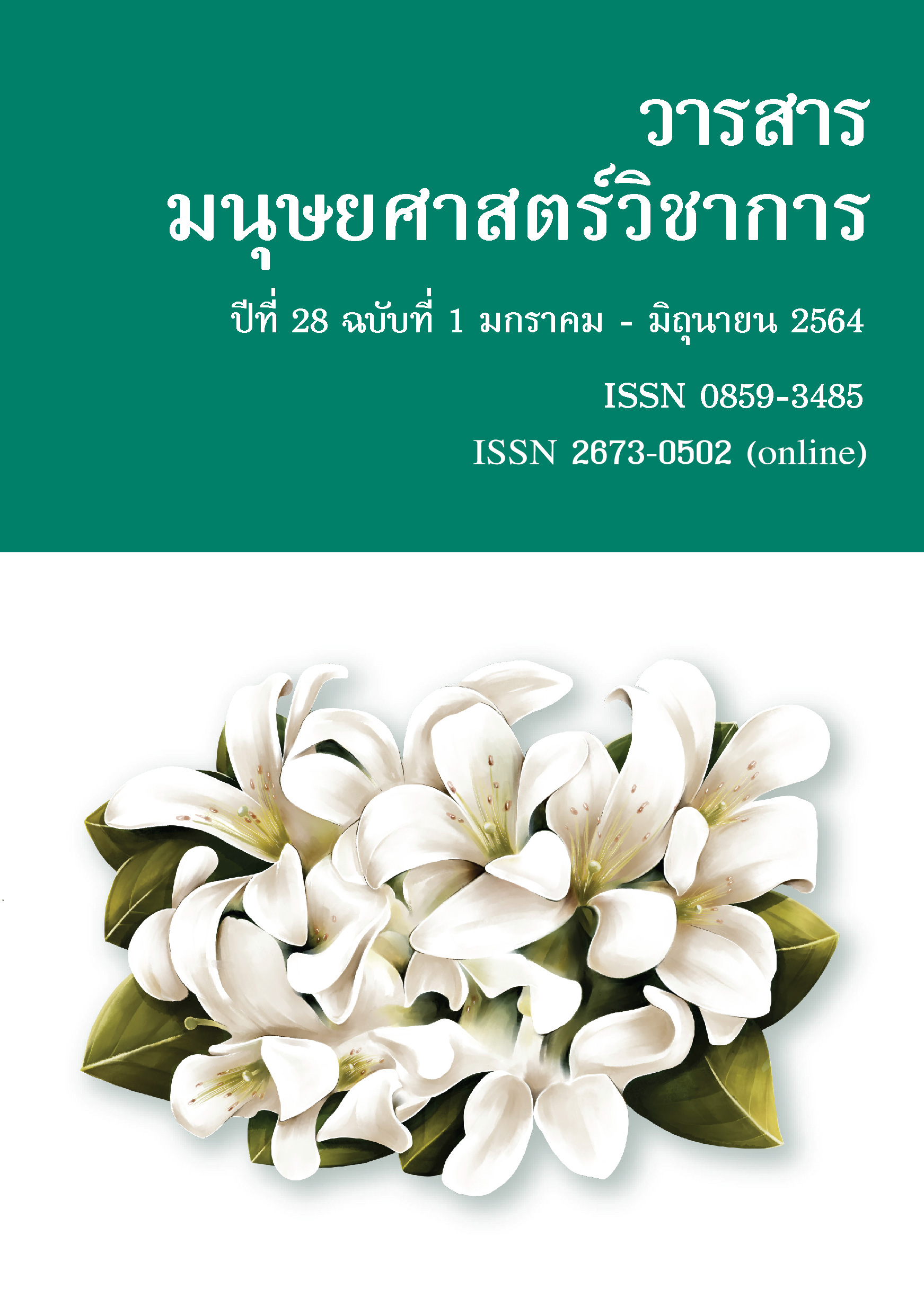Semantic Interpretation in Relation to Syntactic Structure of Thai Toponyms Written in French
Main Article Content
Abstract
This study aims to investigate the relation between syntax and semantic interpretation of Thai toponyms in French guidebooks on Thailand by emphasizing the modified toponyms in terms of syntactic structure. The data were collected from 4 French guidebooks including le Routard, le Guide vert, Le Petit Futé and Encyclopédie du voyage. The results show that the syntactic modification affects the mode of reference. Two types of semantic interpretation are identified: a metaphoric interpretation and an image-constr uction interpretation. For the metaphoric interpretation, a usual referent is transferred to a discursive referent, which has some common characteristics. The usual referent becomes a class that readers could imagine how the mentioned place looks like. For the image interpretation, the structure is identical with the metaphoric toponym, but the mode of reference is different. It always refers to the same referent, but only one facet is presented in a spec ific context. These results also demonstrate that even a proper noun is defin ed as meaningless according to philosophy of language. And, the interpretation of modified toponyms revealed the semantic transfer from one place to another place. Furthermore, the criteria of singularity of the proper noun might be controversial due to the image interpretation.
Article Details
References
กรมการท่องเที่ยว. (2562). สถิตินักท่องเที่ยวชาวต่างชาติที่เดินทางเข้าประเทศไทย ปี 2561. สืบค้นเมื่อ 8 มิถุนายน 2562 จาก https://www.mots.go.th/more_news.php?cid= 502&filename=index
ประพนธ์ เรืองณรงค์. (2558). ชื่อบ้าน นามเมืองภาษามลายูในคาบสมุทรไทย. ดำรงวิชาการ, 14(1), 11-32.
สำนักราชบัณฑิตยสภา. (2560). พจนานุกรมศัพท์ภาษาศาสตร์ ฉบับราชบัณฑิตยสภา. กรุงเทพฯ: ราชบัณฑิตยสภา.
Bakah, E. K. (2010). Analyse du discours oral des guides touristiques et du discours écrit des guides de voyage: régularités discursives et perspectives didactiques. (Thèse de doctorat). Université de Strasbourg, Strasbourg.
Cappelli, G. (2013). Travelling words: Languaging in English tourism discourse In A. Yarrington, S. Villani, & J. Kelly (Eds.), Travels and Translations. Anglo-Italian Cultural Transactions (pp. 353-374). Amsterdam/New York: Rodopi.
Chansuriya, K. (2004). Analyse du discours des guides de voyage en français sur la Thaïlande. (Thèse de octorat). Université Chulalongkorn, Bangkok.
Gary-Prieur, M.-N. (1991). La modalisation du nom propre. Langue française, 92(1), 44-63.
Gary-Prieur, M.-N. (1994). Grammaire du nom propre. Paris: Puf.
Gary-Prieur, M.-N. (2001). Individu pluriel: les noms propres et le nombre. Paris: CNRS.
Gary-Prieur, M.-N. (2011). Le nom propre comme « nom du discours », In Y. Baudelle, & E. Nardout-Lafarge (Eds.), Nom propre et écriture de soi (pp. 233-247). Montréal: Les presses de l’Université de Montréal.
Jonasson, K. (1991). Les noms propres métaphoriques: constructions et interprétations. Langue française, 92, 64-81.
Jonasson, K. (1994). Le nom propre: constructions et interprétations. Louvainla-Neuve: Duculot.
Kleiber, G. (1981). Problèmes de référence: descriptions définies et noms propres. Paris: Klincksieck.
Leroy, S. (2004). Le nom propre en français. Paris: Ophrys.
Leroy, S. & Muni Toke, V. (2007), Une date dans la description linguistique du nom propre: l’Essai de grammaire de la langue française de Damourette et Pichon. Lalies, 27, 115-190.
Léchauguette, S. (2011). Le traitement du nom propre dans la traduction des ouvrages pragmatique : Le cas des guides touristiques. Forum, 9(1), 59-89.
Margarito, M. (Ed.) (2000). L’Italie en stéréotypes. Paris: L’Harmattan.
Mastercard. (2018). Mastercard’s 2018 Global Destination Cities Index. Retrieved June 8, 2018, from https://newsroom.mastercard.com/press-releases/big-cities-big-business-bangkok-london-and-paris-leadthe-
way-in-mastercards-2018-global-destination-cities-index/
Mourhon-Dallies, F. (1992). Travailler avec les écrits touristiques. Français dans le monde, 251, 54-58.
Noailly, M. (1991). L’énigmatique Tombouctou : nom propre et position de l’épithète. Langue française, 92, 1014-113.
PIPAME. (2011). Prospective du M-Tourisme, novembre 2011. Paris: Ministère de l’Économie, des Finances et de l’Industrie.
Reboul-Touré, S. (2000). « C’est très italien » : quelques marqueurs linguistiques pour déjouer les stéréotypes. In M. Margarito (Ed.), L’Italie en stéréotypes (pp. 153-171). Paris: L’Harmattan.
Roungtheera, T. (2014). Stéréotypes sur les Thaïlandais dans deux guides touristiques sur la Thaïlande: études de quelques marqueurs linguistiques. Bulletin de l’ATPF, 128, 13-23.
Seoane, A. (2013). Les mécanismes énonciatifs dans les guides touristiques : entre genre et positionnements discursifs. Paris: L’Harmattan.
Wansen-Kaseva, A. (2008). Stéréotypisation d’un peuple dans le discours touristique : étude sur la représentation des Finlandais en tant qu’habitants d’un pays cible touristique . (Mémoire de maîtrise ). Université de Tampare, Tampare.


